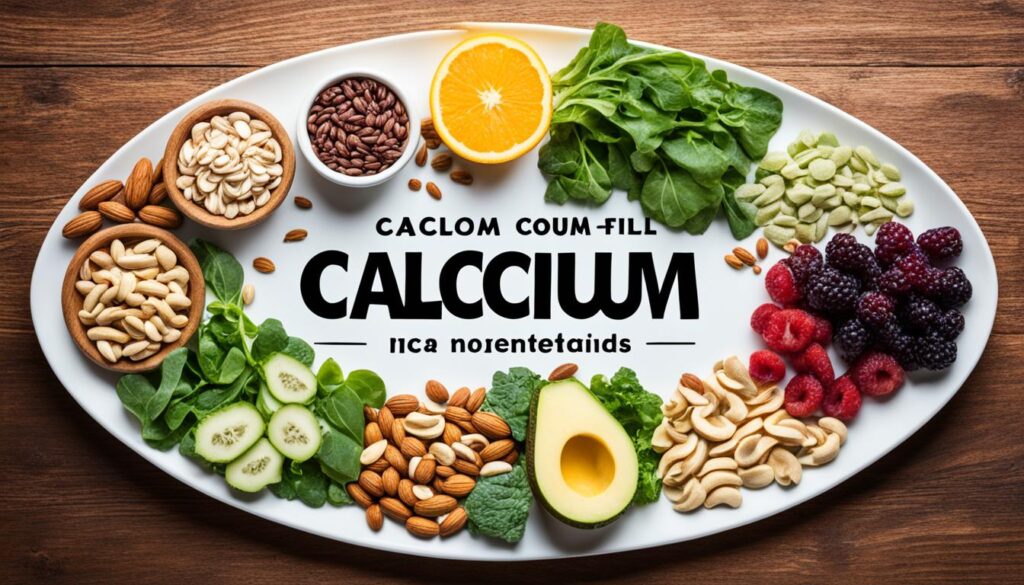Where Calcium Is Found in Foods

Do you know where calcium is found in foods? Many people believe that dairy products are the only source of calcium, but is that really true? If you’re curious to learn about the different sources of calcium and how you can ensure you’re getting enough in your diet, read on!
Key Takeaways:
- Calcium is a mineral that is essential for healthy bones and teeth.
- About 99% of the body’s calcium is stored in the bones.
- Calcium can be obtained through the diet by consuming foods or supplements that contain it.
- There are various sources of calcium, including dairy products, leafy greens, almonds, and calcium-fortified foods.
- It’s important to meet the recommended daily intake of calcium to support overall health.
Importance of Calcium in the Body
Calcium plays a crucial role in maintaining overall health and well-being. This essential mineral is primarily known for its role in building and strengthening bones and teeth. Calcium is not limited to bone health; it also performs various functions throughout the body.
Functions of Calcium:
- Bone and Teeth Health: Calcium is a key component of bone and teeth structure, providing strength and support.
- Blood Clotting: Calcium is necessary for blood clotting, a vital process that helps prevent excessive bleeding in case of injury.
- Muscle Contraction: Calcium ions are involved in muscle contraction, allowing muscles to contract and relax properly. This function is crucial for physical movement and overall body coordination.
- Heart Rhythms and Nerve Functions: Calcium plays a role in regulating heart rhythms, ensuring a steady and coordinated heartbeat. It also aids in transmitting nerve impulses throughout the body, facilitating proper communication between nerves.
The body carefully maintains a balance of calcium levels in the blood and tissues to support these functions. If calcium levels drop too low, the body compensates by releasing calcium from the bones. Conversely, excess calcium can be excreted through the urine or stored in the bones.
Vitamin D, activated by parathyroid hormone, helps improve calcium absorption in the intestines. Another hormone called calcitonin is responsible for lowering calcium levels in the blood by inhibiting the release of calcium from the bones and increasing its excretion through the kidneys.
Risks of Calcium Imbalance
It is important to maintain proper calcium levels in the body to prevent deficiencies or toxicity. Calcium deficiency, known as hypocalcemia, can lead to symptoms such as muscle cramps, abnormal heart rate, and weakened bones. On the other hand, excess calcium in the blood, known as hypercalcemia, can cause fatigue, nausea, and irregular heart rate.
“Calcium is a fundamental mineral that supports bone health, muscle function, and overall well-being.”
| Function | Importance |
|---|---|
| Bone and Teeth Health | Provides strength and structure. |
| Blood Clotting | Ensures timely clotting to prevent excessive bleeding. |
| Muscle Contraction | Enables proper movement and coordination of muscles. |
| Heart Rhythms and Nerve Functions | Regulates heartbeat and facilitates nerve communication. |
Recommended Calcium Intake
The Recommended Dietary Allowance (RDA) for calcium varies based on age and gender. It is important to meet the recommended intake of calcium to support overall health and prevent deficiencies.
RDA for Calcium
For women between the ages of 19-50, the RDA is 1,000 mg per day. Women 51 years and older have an RDA of 1,200 mg per day. Pregnant and lactating women also have an RDA of 1,000 mg per day.
For men between the ages of 19-70, the RDA is 1,000 mg per day, while men 71 years and older have an RDA of 1,200 mg per day.
| Age | RDA for Calcium (mg/day) | |
|---|---|---|
| Women | Men | |
| 19-50 | 1,000 | 1,000 |
| 51+ | 1,200 | 1,200 |
| Pregnant & Lactating | 1,000 | N/A |
It is important to ensure you meet the daily recommended intake of calcium to support bone health, muscle function, and other essential bodily processes.

Food Sources of Calcium
Calcium is an essential mineral that can be obtained from a variety of foods, not just dairy products. Incorporating these calcium-rich foods into your diet can help ensure you meet your daily calcium requirements:
- Dairy products: Milk, yogurt, and cheese are excellent sources of calcium.
- Calcium-fortified plant-based milks: Almond milk, soy milk, and other plant-based milks fortified with calcium are good alternatives for those who are lactose intolerant or follow a vegan diet.
- Leafy greens: Foods like kale and spinach are not only packed with other essential nutrients but are also high in calcium.
- Almonds: These tasty nuts are a great snack option and also provide a good amount of calcium.
- Calcium-fortified orange juice: Start your day with a glass of calcium-fortified orange juice to boost your calcium intake.
- Canned sardines and salmon (with bones): These fish options are not only rich in omega-3 fatty acids but also contain edible bones that are a great source of calcium.
- Tofu made with calcium sulfate: Incorporating tofu into your meals can provide you with a plant-based source of calcium.
It’s important to note that the bioavailability of calcium can vary in different foods. While dairy foods have a lower bioavailability at around 30%, plant-based foods like leafy greens have a higher bioavailability, ensuring that your body can efficiently absorb and utilize the calcium they contain.
However, it’s worth mentioning that some plant foods contain anti-nutrients like oxalates and phytates. These compounds can bind to calcium and decrease its absorption. So, while these foods are still valuable sources of calcium, it’s important to maintain a varied and balanced diet to ensure an adequate calcium intake.

Signs of Calcium Deficiency and Toxicity
Calcium deficiency, also known as hypocalcemia, can lead to various symptoms that indicate an inadequate calcium level in the body. Some common symptoms of hypocalcemia include:
- Muscle cramps or weakness
- Numbness or tingling in the fingers
- Abnormal heart rate
- Poor appetite
Hypocalcemia can occur in individuals who do not consume enough dietary calcium or have conditions that interfere with calcium absorption. It is important to ensure a sufficient intake of calcium to prevent deficiencies and maintain overall health.
On the other hand, an excessive amount of calcium in the blood, known as hypercalcemia, can also cause notable symptoms. These symptoms may include:
- Weakness and fatigue
- Nausea and vomiting
- Shortness of breath
- Chest pain
- Irregular heart rate
Hypercalcemia can result from various factors, such as excessive calcium intake, certain medical conditions, or medications. Maintaining an appropriate balance of calcium in the body is essential to avoid both deficiencies and toxicity.
Regular monitoring of calcium levels and awareness of the symptoms associated with calcium deficiency or toxicity are crucial for maintaining optimal health. If you experience any concerning symptoms, it is recommended to consult with a healthcare professional for assessment and guidance.
therefore,
Calcium is a vital mineral that plays a significant role in maintaining overall health, especially in the development and strength of bones and teeth. It is crucial to ensure an adequate intake of calcium-rich foods to meet the body’s calcium needs. Some excellent sources of calcium include dairy products like milk, yogurt, and cheese, as well as leafy greens, almonds, and calcium-fortified foods. These options provide a variety of choices for individuals with different dietary preferences.
When considering calcium sources, it’s important to note the bioavailability of calcium in different foods. While dairy products have a lower bioavailability, plant-based sources like leafy greens offer higher absorption rates. It’s also essential to be aware of substances like oxalates and phytates that can hinder calcium absorption.
To maintain optimal health, it is recommended to meet the daily recommended intake of calcium. This intake varies based on factors such as age and gender, with women and older adults generally having higher requirements. By consuming sufficient calcium and paying attention to calcium-rich food choices, individuals can support their bone health and prevent deficiencies or toxicity.
FAQ
Where is calcium found in foods?
What are the sources of calcium?
What are the recommended daily intakes of calcium?
What are some high calcium foods?
What are the signs of calcium deficiency and toxicity?









